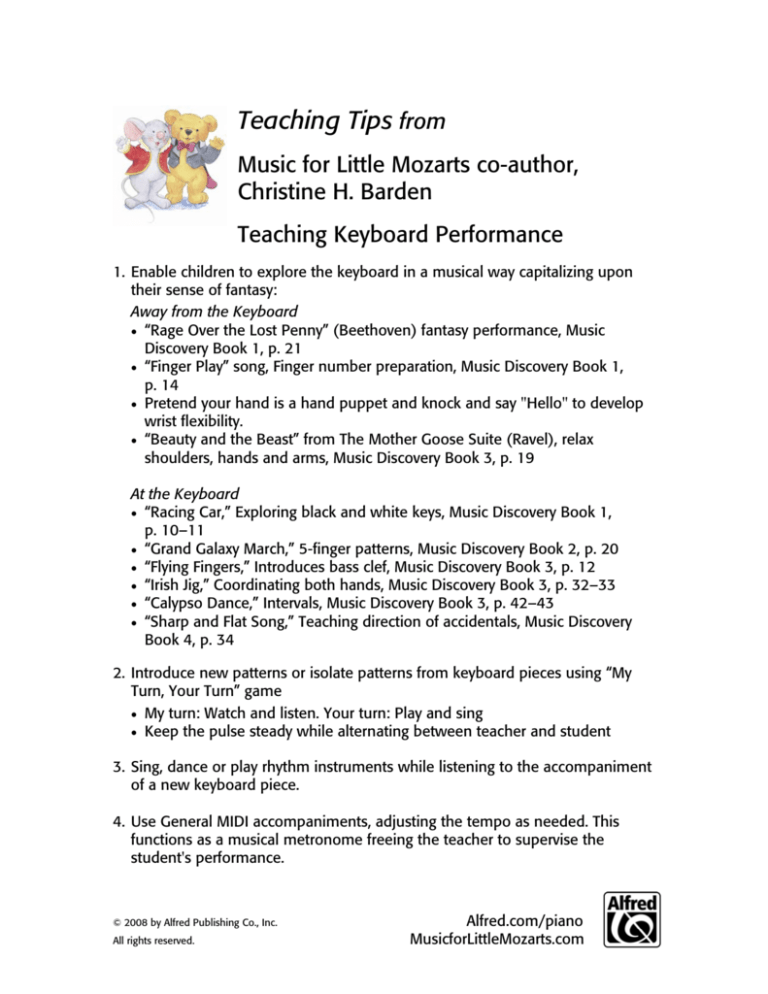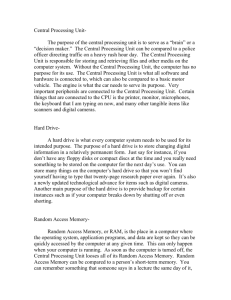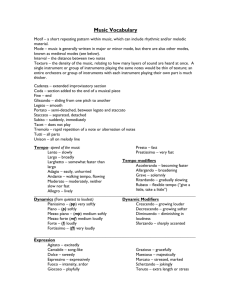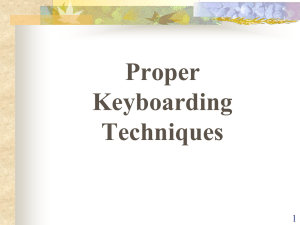
Teaching Tips from
Music for Little Mozarts co-author,
Christine H. Barden
Teaching Keyboard Performance
1. Enable children to explore the keyboard in a musical way capitalizing upon
their sense of fantasy:
Away from the Keyboard
“Rage Over the Lost Penny” (Beethoven) fantasy performance, Music
Discovery Book 1, p. 21
“Finger Play” song, Finger number preparation, Music Discovery Book 1,
p. 14
Pretend your hand is a hand puppet and knock and say "Hello" to develop
wrist flexibility.
“Beauty and the Beast” from The Mother Goose Suite (Ravel), relax
shoulders, hands and arms, Music Discovery Book 3, p. 19
At the Keyboard
“Racing Car,” Exploring black and white keys, Music Discovery Book 1,
p. 10–11
“Grand Galaxy March,” 5-finger patterns, Music Discovery Book 2, p. 20
“Flying Fingers,” Introduces bass clef, Music Discovery Book 3, p. 12
“Irish Jig,” Coordinating both hands, Music Discovery Book 3, p. 32–33
“Calypso Dance,” Intervals, Music Discovery Book 3, p. 42–43
“Sharp and Flat Song,” Teaching direction of accidentals, Music Discovery
Book 4, p. 34
2. Introduce new patterns or isolate patterns from keyboard pieces using “My
Turn, Your Turn” game
My turn: Watch and listen. Your turn: Play and sing
Keep the pulse steady while alternating between teacher and student
3. Sing, dance or play rhythm instruments while listening to the accompaniment
of a new keyboard piece.
4. Use General MIDI accompaniments, adjusting the tempo as needed. This
functions as a musical metronome freeing the teacher to supervise the
student's performance.
© 2008 by Alfred Publishing Co., Inc.
All rights reserved.
Alfred.com/piano
MusicforLittleMozarts.com
5. Choose from the list of instructions for each piece in the Music Lesson Book.
Establish a good practice habit by drawing a “practice box” around a difficult
measure or section. As pieces become longer, teach students to start with the
more challenging section, rather than always starting at the beginning.
6. Develop a repertoire of short pieces, even from the earliest stages. Students
should memorize pieces that they can perform anywhere, anytime.
Avoid checking off a piece each week as a goal. Students can develop
confidence and good technique by continuing to perform pieces that they
have mastered.
Begin to apply the fantasy techniques learned earlier to the actual keyboard
performance.
7. Ask students to give “concerts” at home for parents and Beethoven Bear,
Mozart Mouse and the rest of their “music friends.” These performances serve
as important preparation for recitals and talent shows. Ask the student to
announce the piece and bow before and after playing. Serve cookies!
Teaching Note Reading
1. Don’t assume that the students know anything!
Review, review, review. As adults, a concept may be
“second nature” to us. Each new note or note value is
carefully introduced in the lesson book and reinforced in
the workbook and on flash cards. However, consistent
review through challenge games is important. It’s good to have the parents
take a turn, too! (Show “Same and Different” and “Switch on the Rest”
games. Ex. line note, line note, line note, Space note!)
2. Use flash cards and magnet boards consistently from level 2 on. Children
sometimes identify a note within the context of a piece they are playing but
will be unable to recognize it on the board.
3. Begin with note values. Have students clap or use rhythm sticks reading
patterns drawn on the board. Let each child take a turn to be the teacher,
pointing to the notes of the pattern on the board. Do the same with flash
cards. (My students have to pass a flash card test as a group before going to
the next level. Parents help them review at home).
4. Students need to be able to count the lines and spaces from bottom to top.
It may seem silly, but there is often confusion identifying note names when
they start counting from the top line rather than from the bottom … parents,
© 2008 by Alfred Publishing Co., Inc.
All rights reserved.
Alfred.com/piano
MusicforLittleMozarts.com
too. (“Drive your magnet car all the way along space #1, then park it at the
end. Now drive your magnet car all the way along space #2,” etc.) Also,
practice identifying line notes and space notes. “Put a magnet on line #1,
now put a magnet in space #1,” etc.
5. Any note VALUE can be placed on any NOTE NAME. This is another
seemingly simple concept which can cause confusion for young students.
“Let’s draw a quarter note on the line of ‘e,’ now a half note.” Or, in the
book, “find me a whole note on the line of middle ‘c.’ Now, how many
quarter notes can you find on ‘d’?” I sometimes draw a whole sequence of
note values as well as a star, heart, happy face on a line or space and have
the children say, “A happy face on ‘f,’ a quarter note on ‘f,’ a whole note on
‘f,’ etc.
6. Use the General MIDI disk or CD accompaniment while students read and
play the rhythm pattern of a new lesson book piece using rhythm sticks. Use
the concept pieces from the Discovery Books many times. “Step and Skip
March” helps children make a kinesthetic connection between what they
see on the page and what their fingers need to do. “The Sharp and Flat
Song” helps them remember sharps to the right, flats to the left.
© 2008 by Alfred Publishing Co., Inc.
All rights reserved.
Alfred.com/piano
MusicforLittleMozarts.com
Sample Piano Class Lesson Plan by Christine H. Barden
Music for Little Mozarts Book 2, Lesson 14
Lesson Focus: Steps and skips
Page
CD or
GM
Track
Discovery
6
CD 1
Discovery
Discovery
handout
Discovery
36
27
CD 19
GM 11
20, 21
CD 10
Lesson
30
GM 21
33
GM 23
Book
As children enter the room, teacher checks
workbook assignment and awards stickers.
Hello Song (Music Lesson Day- sing
w/”helpers”)
Skip to My Lou (singing with movement)
Listen & Sing #5 with scarves
Keyboard Signal Song
Grand Galaxy March (keyboard warm-up)
Stepping Fun, Teacher: “Tell me everything you
notice.”
Stepping Down (LH)
Reading skips in bass clef (c to a) color at
home
A Bunny’s Wish
Step & Skip March (walk toe to toe, hop
instead of skipping)
Skipping Fun (my turn, your turn)
Brother John (rhythm ensemble)
Solo Time (if time allows)
Goodbye Song (It’s Time to Say Goodbye)
Workbook
Workbook
35
Lesson
34
GM24
Discovery
38
GM 16
Lesson
Discovery
35
14
GM 25
GM 5
Discovery
48
30,
33,
34, 35
14,
15,
36, 38
GM 20
Lesson
Homework
Discovery
Note: for a very young class I might eliminate one keyboard piece and add “JS
Bunny’s Hop.” The younger the class, the more action they need.
© 2008 by Alfred Publishing Co., Inc.
All rights reserved.
Alfred.com/piano
MusicforLittleMozarts.com





